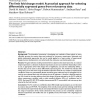Free Online Productivity Tools
i2Speak
i2Symbol
i2OCR
iTex2Img
iWeb2Print
iWeb2Shot
i2Type
iPdf2Split
iPdf2Merge
i2Bopomofo
i2Arabic
i2Style
i2Image
i2PDF
iLatex2Rtf
Sci2ools
BMCBI
2002
2002
The limit fold change model: A practical approach for selecting differentially expressed genes from microarray data
Background: The biomedical community is developing new methods of data analysis to more efficiently process the massive data sets produced by microarray experiments. Systematic and global mathematical approaches that can be readily applied to a large number of experimental designs become fundamental to correctly handle the otherwise overwhelming data sets. Results: The gene selection model presented herein is based on the observation that: (1) variance of gene expression is a function of absolute expression; (2) one can model this relationship in order to set an appropriate lower fold change limit of significance; and (3) this relationship defines a function that can be used to select differentially expressed genes. The model first evaluates fold change (FC) across the entire range of absolute expression levels for any number of experimental conditions. Genes are systematically binned, and those genes within the top X% of highest FCs for each bin are evaluated both with and without th...
| Added | 17 Dec 2010 |
| Updated | 17 Dec 2010 |
| Type | Journal |
| Year | 2002 |
| Where | BMCBI |
| Authors | David M. Mutch, Alvin Berger, Robert Mansourian, Andreas Rytz, Matthew-Alan Roberts |
Comments (0)

